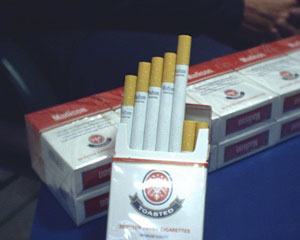
INTERNATIONAL brands continued to drive British American Tobacco (BAT) Zimbabwe’s total sales volumes for the year ended December 31 2012, as local varieties took a knock after Treasury revised excise duty upwards and a depressed retail selling price.
BY our staff
Excise duty on cigarettes was revised upwards to US$15 per 1 000 sticks from US$10 per 1 000 sticks effective December 1 last year.
Company chairman, Kennedy Mandevhani said BAT continues to lead the cigarette industry despite a decrease in sales volumes by 11% from the previous year.
“However, Dunhill achieved outstanding volume growth of 43% as compared to the previous year since it is not a mass market brand,” he said.
The company’s main brand, Madison, continued to be its major drive brand, contributing 68% of national sales volume. BAT Zimbabwe witnessed a decrease in sales volumes across all brands at the end of 2011.
In its audited results for the year ended December 31 2012, BAT Zimbabwe’s operating revenue recorded significant growth, reaching US$51,8 million, up by 30% over the same period last year.
The company’s current ratio, which measures liquidity, stood at 1,3 from a previous ratio of 1,02 prevalent during the previous year.
- Chamisa under fire over US$120K donation
- Mavhunga puts DeMbare into Chibuku quarterfinals
- Pension funds bet on Cabora Bassa oilfields
- Councils defy govt fire tender directive
Keep Reading
According to standard practice, companies which have ratios that hover around or below 1 should only be those which have sufficient inventories that can quickly be converted into cash in order to pay debts as they fall due.
Turning to assets utilisation, the total assets turnover ratio, which measures the company’s ability to use its assets efficiently so as to generate sales, stood at an improved 1,54 as compared to a ratio of 1,25 recorded in 2011.
“The group continues to place emphasis on promoting sales growth across the product portfolio, while also ensuring that demand for all products is met at all times on a national basis. Our trade marketing and distribution activities have been successful in ensuring we achieve the much needed sales growth and share of the market,” Mandevhani said.
This ratio incorporates all assets, current and fixed, reflecting the company’s improved sales figures.
The inventory turnover stood at 1,62 during the period under review. This ratio shows the quality of sales management and measures how effectively funds invested in inventory are being converted into sales revenue.
The company’s lower inventory turnover rate, is reflective of the capital intensive nature of the business as compared to others. Net Profit margin ratio stood at 23% as at 2012, as compared to 10% the previous year, reflecting increased profitability.
Such margins vary between different companies with particular importance upon pricing strategies and the company’s product mix.











